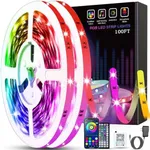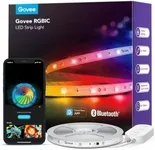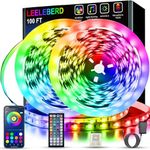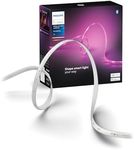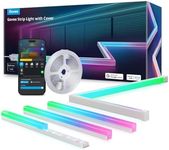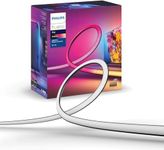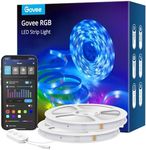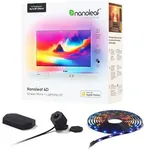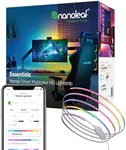Buying Guide for the Best Led Lightstrips
LED light strips are a versatile and energy-efficient way to add lighting to various spaces in your home or office. They can be used for accent lighting, task lighting, or even as a primary light source in some cases. When choosing the right LED light strip for your needs, it's important to consider several key specifications to ensure you get the best performance and functionality for your specific application.Brightness (Lumens)Brightness, measured in lumens, indicates how much light the LED strip emits. This is important because it determines how well the light strip will illuminate your space. For accent lighting, a lower lumen output (around 200-500 lumens per meter) is usually sufficient. For task lighting or primary lighting, you may need a higher lumen output (800-1500 lumens per meter). Consider the purpose of the lighting and the size of the area you want to illuminate when choosing the brightness level.
Color TemperatureColor temperature, measured in Kelvin (K), describes the color of the light emitted by the LED strip. This is important because it affects the ambiance and functionality of the lighting. Warm white (2700K-3000K) creates a cozy and inviting atmosphere, making it ideal for living rooms and bedrooms. Neutral white (3500K-4500K) is suitable for kitchens and workspaces, providing a balanced light. Cool white (5000K-6500K) is best for task-oriented areas like garages and workshops, as it offers a bright and clear light. Choose the color temperature based on the mood and purpose of the lighting in your space.
Color OptionsLED light strips come in single-color and multi-color (RGB or RGBW) options. Single-color strips are great for consistent lighting needs, while multi-color strips offer the flexibility to change colors and create different lighting effects. RGB strips can produce a wide range of colors, while RGBW strips include an additional white LED for better white light quality. If you want dynamic lighting that can change colors for different occasions or moods, go for RGB or RGBW strips. For a more straightforward and consistent lighting solution, single-color strips are sufficient.
Length and CutabilityThe length of the LED strip is crucial because it determines how much area you can cover with the lighting. LED strips are typically sold in reels of 1 to 5 meters, but they can often be cut to fit your specific needs. This is important for customizing the lighting to fit your space perfectly. Check the product specifications to see where the strip can be cut, usually marked by cut lines. Measure the area you want to light and choose a strip that can be cut to the appropriate length without wasting too much material.
Waterproof Rating (IP Rating)The waterproof rating, indicated by an IP (Ingress Protection) rating, tells you how well the LED strip is protected against dust and water. This is important if you plan to use the light strip in areas exposed to moisture, such as bathrooms, kitchens, or outdoor spaces. An IP65 rating means the strip is protected against water jets and is suitable for damp environments. An IP67 rating means the strip can be submerged in water up to 1 meter, making it ideal for outdoor use. Choose the appropriate IP rating based on where you plan to install the LED strip.
Power Supply and VoltageLED light strips require a power supply to operate, and the voltage of the strip must match the power supply. Common voltages for LED strips are 12V and 24V. This is important because using the wrong voltage can damage the strip or reduce its lifespan. Ensure you have a compatible power supply that can handle the total wattage of the strip. Calculate the total wattage by multiplying the wattage per meter by the length of the strip. Choose a power supply with a slightly higher wattage than the total to ensure reliable performance.
Control OptionsControl options for LED light strips include basic on/off switches, dimmers, remote controls, and smart home integration. This is important for convenience and customization of your lighting experience. Basic on/off switches are straightforward but offer limited control. Dimmers allow you to adjust the brightness, while remote controls provide more flexibility in changing colors and effects. Smart home integration lets you control the lights via apps or voice commands. Choose the control option that best fits your lifestyle and how you plan to use the lighting.
